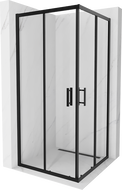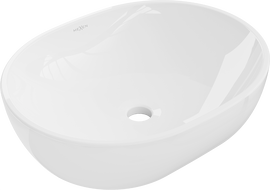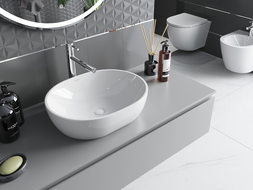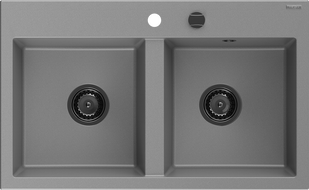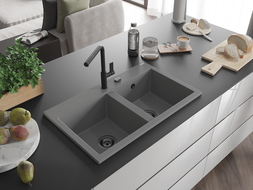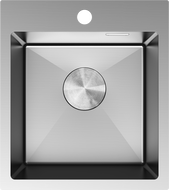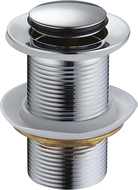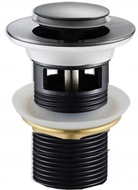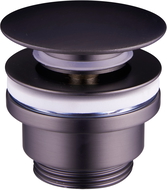
No matter what type of solutions we have in our bathroom, obstacles may always arise. In this case, we have focused on the most common problems faced by owners of a click-clack stopper, also known as an automatic stopper. Like any other mechanism, it has its advantages, which encourage many consumers to purchase it. However, it should be noted that clogging can occur with this mechanism. This is directly due to the construction of the click-clack stopper. Below we will explain the specifics of how the automatic stopper works and the issue of clogging. We will also advise what can help in such a situation.
Click-clack stopper - how does it work?
How does the repair of an automatic sink stopper look? Before we describe it, let's explain the nature of these types of stoppers. They are characterized primarily by their unusual and automatic construction. They consist of a stopper placed in the drain hole, which we regulate with a lever, previously mounted on the tap. To close the water outlet, we pull the lever, and the mechanism clamps the stopper in the sink and blocks the water flow. If we want to release the water back into the circuit, we just need to press the lever, which will open the stopper.
Inside the drain pipe, there is a blockage that, depending on our will (lever movement), regulates the tightening or opening of the stopper and the water flow path. At the bottom of the entire construction are two metal rods that regulate our lever. The lever we control is managed by the vertical rod. The horizontal rod directly affects the stopper, making it open or close.
The click-clack stopper works similarly simple, although the mechanism itself is much more simplified. You just need to click the stopper to block the water outlet and then click - press it again to unblock the outlet. Hence the rather amusing name - click-clack stopper.
The most common causes of drain clogging
When our stopper fails and clogging occurs, we must identify the cause to eliminate it. The most common reasons for such malfunctions include issues with the plastic catch that holds both the horizontal and vertical rods. This usually occurs because this element is made of plastic, so it can easily break. This can even happen during the assembly of the construction by overtightening with a screwdriver.
Sometimes, the click-clack stopper gets blocked due to an unusual cause, such as pulling the lever too hard. In this situation, it's worth first taking a look under the cabinet and gently pulling down the end of the metal rod placed horizontally. In most cases, this action is helpful and makes the stopper immediately pop out of the clogged drain. Another reason could be a problem with the clamps, which also affect the operation of the lever. Under the sink, you'll find two metal clamps located on the vertical metal rod under the plastic catch. When the plastic catch breaks, the clamps will block the stopper so it won't fall down completely without the possibility of automatic lifting.
By having clamps on either side, we secure ourselves for the future should such a failure occur. It is important to consider the appropriate diameter of the clamp so that it fits our rod. It also happens that when we have a click-clack stopper in our sink, the cause might be a simple stone, which makes the stopper work much worse and, what happens very often, simply does not close properly after being clicked.
How to effectively unclog a click-clack stopper in a sink?
- At the very beginning, take a look under the sink and see if you notice any unusual changes.
- If the plastic catch is broken, the situation is clear. You need to simply replace it with a new one. Remember, it's worth reinforcing the entire construction with metal clamps, as we wrote above. This way, the stopper won't fall to the bottom during the next failure, and the whole process will be easier.
- If, however, you don't see typical causes related to the damage of any described elements, try cleaning the drain from stone.
- At first, try to remove the stopper by prying it upward so as not to damage the drain or the stopper itself.
- For cleaning, we can use popular products available on the market based on sodium hydroxide.
- During cleaning, remember to exercise caution!
- To prevent stopper clogging, it's worth periodically cleaning the entire drain and pipes of stones and any elements that could lead to blockages.
- Sometimes, due to our inattention, something can fall into the drain that completely blocks the click-clack stopper mechanism. Then it might be necessary to completely disassemble the bathroom structure and mechanically remove the cause.
If none of the most popular methods work, we need to deal with disassembling the siphon and the stopper step by step. It is important in this situation to equip yourself with the appropriate tools and replacement parts for old ones. At the very beginning, make sure you have removed excess water from the sink, which could spill onto the floor when opening the siphon. If you don't want to attempt the repair yourself, call for plumbing assistance, which will undoubtedly provide you with support.


